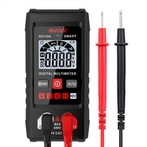Calibration and electrode use of desktop dissolved oxygen meter
The dissolved oxygen sensor of the desktop dissolved oxygen analyzer is covered with a layer of fluorescent material. When the blue light emitted by the LED light source illuminates the fluorescent material on the sensor surface, the fluorescent material is excited and releases red light. The period from emitting blue light to releasing red light is recorded. The higher the oxygen concentration in water, the shorter the time it takes to release red light. Establishing a correlation between the red light release time and dissolved oxygen concentration, a desktop dissolved oxygen analyzer calculates the dissolved oxygen concentration by measuring the red light release time, and then directly displays the dissolved oxygen concentration on the screen.
Calibration of desktop dissolved oxygen analyzer:
The dissolved oxygen sensor of the desktop dissolved oxygen analyzer is covered with a layer of fluorescent material. When the blue light emitted by the LED light source illuminates the fluorescent material on the sensor surface, the fluorescent material is excited and releases red light. The period from emitting blue light to releasing red light is recorded. The higher the oxygen concentration in water, the shorter the time it takes to release red light. Establishing a correlation between the red light release time and dissolved oxygen concentration, a desktop dissolved oxygen analyzer calculates the dissolved oxygen concentration by measuring the red light release time, and then directly displays the dissolved oxygen concentration on the screen.
Calibration of desktop dissolved oxygen analyzer:
The dissolved oxygen analyzer can generally be calibrated using standard solution or on-site sampling.
1. Standard solution calibration method:
Standard solution calibration generally adopts two-point calibration, and ultrasonic thickness gauge includes zero point calibration and range calibration. The zero calibration solution can be a 2% Na2SO3 solution. The range calibration solution can be selected as a 4M KCl solution (2mg/L) based on the instrument measurement range; Humidity sensor probe, stainless steel electric heating tube, PT100 sensor, fluid solenoid valve, cast aluminum heater, heating coil with 50% methanol solution (21.9mg/L).
2. On site sampling calibration method:
In the actual use of desktop dissolved oxygen analyzers, this method is often used for on-site calibration of dissolved oxygen analyzers. There are two situations when using this method: when sampling, the instrument reading is M1, the assay analysis value is A, and when calibrating the instrument, the instrument reading is still M1. At this time, only adjust the instrument reading to be equal to A; When sampling, the instrument reading is M1 and the assay value is A. When calibrating the instrument, the instrument reading changes to M2. At this time, the adjustment instrument reading cannot be equal to A. Instead, the ultrasonic thickness gauge should be adjusted to 1MA x M2.
Use of desktop dissolved oxygen analyzer electrodes:
The electrode of the dissolved oxygen meter should be cleaned every 1-2 weeks. If there are pollutants on the membrane, it can cause measurement errors. Be careful not to damage the diaphragm during cleaning. Rinse the dissolved oxygen meter electrode in clean water. If the dirt cannot be removed, carefully wipe it with a soft cloth or cotton cloth.






